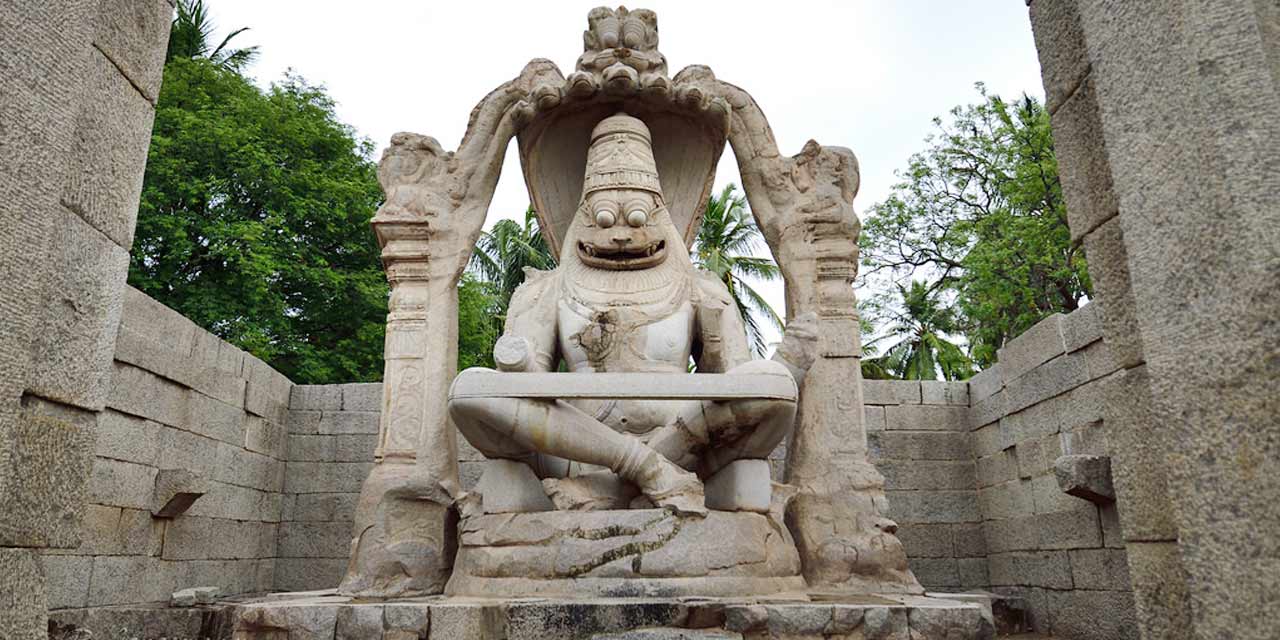
Bharat is a land blessed with a unique culture. The principles of dharma and the teachings of sages and saints guide this great land. Even our everyday interactions and chores get introspected as rightful actions or wrongdoings. In a society, whenever there is an increase in wrongdoings, to put the system in balance, Gods and Goddess take an avatar ( incarnation) and descend upon the earth to save the righteous ones/devotees.
An Avatar is a Sanskrit word. It means descent (of a God) from the sky. Bhagavad Gita ( Chapter 4, verse 7) says: Whenever and wherever there is a decline in the dharma ( religious practices) when adharma/ evil starts to triumph (over dharma), I would descend to save the human race and annihilate the miscreants. Thus re-establishing harmony and dharma.
Hence, it has always been a practice of various Gods and Goddesses taking their avatars to save their devotees and, in the process, annihilate the troublemakers. Lord Narasimha and Lord Sarabha are powerful avatars of Lord Vishnu and Lord Shiva.
THE AVATAR OF LORD NARASIMHA
When Lord Vishnu (Varaha avatar) annihilated the demon Hiranyaksha, his brother, Hiranyakashipu, was aggrieved. Hiranyakashipu wanted to avenge his brother’s death. He first consoled his mother, then the sons and wife of Hiranyaksha. He instructed everyone in his kingdom to refrain from praying to the Gods and Goddesses.
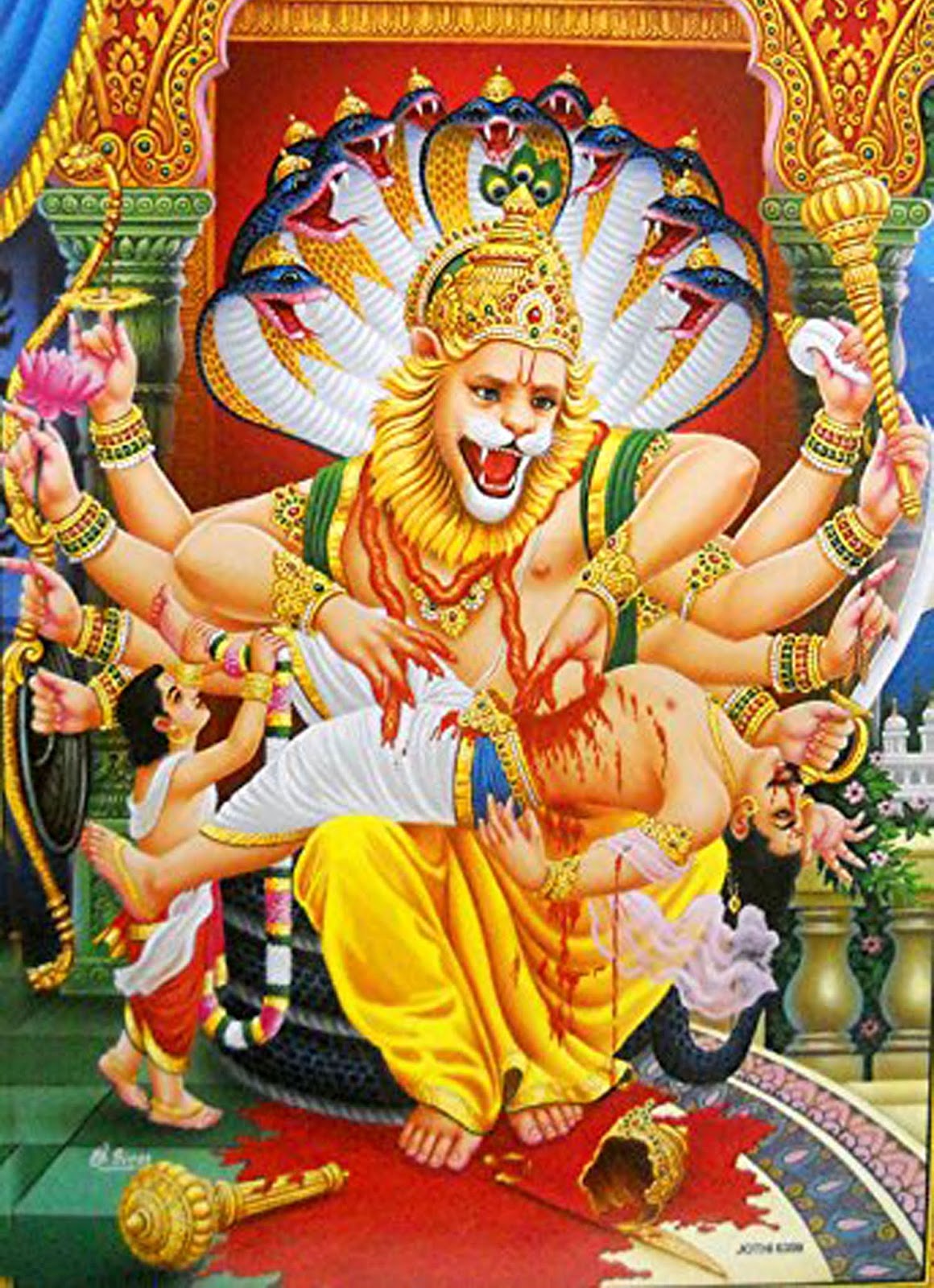 Hiranyakashipu did not wish to die like his brother. He wanted to become an immortal. Hence, he decided to undertake a penance. He entered the Mandara mountain valley and performed intense meditation for years.
Hiranyakashipu did not wish to die like his brother. He wanted to become an immortal. Hence, he decided to undertake a penance. He entered the Mandara mountain valley and performed intense meditation for years.
It is said in Srimad Bhagavatham (7.3) that the penance was so severe that, at a point, a fire started emanating from Hiranyakashipu’s head. As a result, thick smoke arose, engulfing the whole place. The smoke reached the sky. Lord Brahma descended upon earth and sprinkled water from his kamandalam ( vessel carrying water) upon Hiranyakashipu. The King of Daitya, Hiranyakashipu, prostrated to Lord Brahma and asked for his boon of immortality.
According to Srimad Bhagavatham (7.3.36), Hiranyakashipu was terrified of Lord Vishnu (since he killed his brother). He requested Lord Brahma in his boon that he not die within or outside any residence, during the day or night, nor on the ground or sky. He also requested Lord Brahma that he does not perish by any weapon, human being or animal.
After obtaining this boon, Hiranyakashipu started harassing all the living creatures, saints and even the Devas. He instructed the demons to disturb the penance, yagna and poojas performed by the saints. The Gods and the Devas approached Lord Vishnu to save them from the evil clutches of Hiranyakashipu.
Hiranyakashipu had four sons, and one of them was Prahlada. Srimad Bhagavatham (7.4.31-32) describes the qualities of Prahlada: The boy Prahlada was qualified and had refined tastes and manners as a Brahmana. He had good character, humble and kind to all living beings and treated everyone with respect. He was free from pride and in complete control over his five senses. Although he was born into the family of Asura ( Daitya), he was a great devotee of Lord Vishnu. He was friendly with everyone and considered everyone equal. Prahlada was absorbed more into the Supreme consciousness (that Hiranyakashipu felt very uneasy).
When Prahlada was in his mother’s (Kayadhu) womb, Narada Muni took her into his ashram. There, Narada Muni gave her many spiritual discourses. Prahlada listened to everything carefully. He absorbed all the teachings directly from Narada Muni.
Hiranyakashipu sent Prahlada to teachers Sanda and Amarka ( sons of Sukracharya) to learn about economics, politics and other subjects to distract him from thinking about Lord Vishnu. But, nothing distracted young Prahlada from being a staunch devotee. Prahlada began talking to his friends ( sons of other demons) about Lord Vishnu. At a point, they became devotees of Lord Vishnu as well. The teachers, Sanda and Amarka, afraid that they would have to endure Hiranyakashipu’s wrath, approached him and confessed about the preaching of Prahlada. Hiranyakashipu became angry and agitated.
Hiranyakashipu decided to kill his son - Prahlada. Srimad Bhagavatham (7.5.43 - 44) describes how Hiranyakashipu tried to kill Prahlada. He threw his son beneath the feet of elephants, threw him among poisonous snakes, hurled him from atop a steep mountain, administered poison, starved him and even threw him into fire and water. Prahlada was still chanting the name of his beloved Lord Vishnu and was immersed deeply in his thoughts.
Hiranyakashipu began to force his son to bow down to him. He believed that he was mightier than any God. Prahlada refused to bow to anybody other than Lord Vishnu. He challenged his father, saying that he -Hiranyakashipu was not God. He began praising the glorifying Lord Vishnu. Hiranyakashipu was agitated . He asked Prahlada if his beloved Lord Vishnu was inside the column. Prahlada replied with a yes. Hiranyakashipu stuck his fist against a column. Out of the cracked pillar came a tumultuous sound. All the other demons in the room were scared. Hiranyakashipu was bewildered and saw the form of Lord Narasimha rise before him.
Srimad Bhagavatham (7.8.19-22) vividly explains the form of Lord Narasimha. It says that Lord Narasimha had angry eyes, the colour of molten gold. He had a fearful face with a shining mane. He had a razor-sharp tongue and teeth. He had a short neck, a thin waist and a broad chest. His body hairs were white as the moon’s rays. He resembled half lion and half man.
Hiranyakashipu started attacking Lord Narasimha with his mace. He was rendered invisible, just like a little insect that falls forcefully into a flame and perishes. Lord Narasimha captured Hiranyakashipu, placed him on his lap, and tore the Daitya to pieces with the nails of his hands. Lord Narasimha’s face and mane were full of blood. He was still shaking with anger as he tore the heart of Hiranyakashipu.
THE AVATAR OF LORD SARABHA
Lord Sarabha is a powerful avatar of Lord Shiva. He is also known as Lord Sharabeshwara or Sharabeshwaramurthi. It is mentioned in the Shiva Purana that Lord Shiva took the avatar of Lord Sarabha to tame and control the Ugra ( anger) of the Narasimha Avatar of Lord Vishnu.
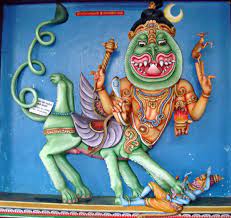 After Lord Narasimha annihilated Hiranyakashipu, everyone ( including the devas and saints) rejoiced and celebrated. They were happy learning of the death of the demon Hiranyakashipu, yet they were scared seeing the Ugram ( anger) of Lord Narasimha. Lord Brahma asked Prahlada to approach Lord Narasimha and to sing praises. Lord Narasimha cooled a bit, but the fury did not subside. Hence, to return to normalcy, the Gods approached Lord Shiva.
After Lord Narasimha annihilated Hiranyakashipu, everyone ( including the devas and saints) rejoiced and celebrated. They were happy learning of the death of the demon Hiranyakashipu, yet they were scared seeing the Ugram ( anger) of Lord Narasimha. Lord Brahma asked Prahlada to approach Lord Narasimha and to sing praises. Lord Narasimha cooled a bit, but the fury did not subside. Hence, to return to normalcy, the Gods approached Lord Shiva.
It is written in the Shiva Puranam ( Section 3 - Satarudra Samhita - 11. 12 - 14) that Lord Shiva sent his leader of the Ganas - Virabhadra, to console and convince the ferocious Lord Narasimha. But Virabhadra could not calm him down.
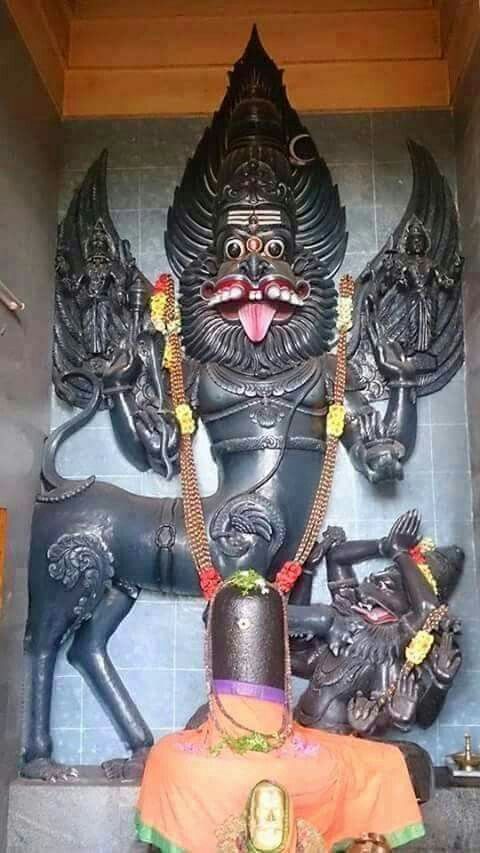 The Shiva Purana (Section 3 - Satarudra Samhita - 12. 8 - 11) talks about the incarnation of Lord Shiva as Sharabha in detail. When Lord Shiva knew of the futile attempts of his trusted Virabhadra, he rose into the avatar of Sarabha. The avatar had many hands, wore matted hair and wore a crescent moon on his head. He appeared like a bird with wings and a beak. He had a fierce body with sharp fangs, a black neck and four legs. He was like a ball of fire, with a voice as loud as the rumbling sound emanating from the clash of clouds. He had three eyes, and they were wide and blazing like fire. His fangs were visible clearly and, from his mouth, aroused the hissing sound.
The Shiva Purana (Section 3 - Satarudra Samhita - 12. 8 - 11) talks about the incarnation of Lord Shiva as Sharabha in detail. When Lord Shiva knew of the futile attempts of his trusted Virabhadra, he rose into the avatar of Sarabha. The avatar had many hands, wore matted hair and wore a crescent moon on his head. He appeared like a bird with wings and a beak. He had a fierce body with sharp fangs, a black neck and four legs. He was like a ball of fire, with a voice as loud as the rumbling sound emanating from the clash of clouds. He had three eyes, and they were wide and blazing like fire. His fangs were visible clearly and, from his mouth, aroused the hissing sound.
An epic battle between the two powerful avatars of Lord Narasimha and Lord Sarabha took place in the sky. Finally, Lord Sarabha controlled the fury of Lord Narasimha. Finally, all the Gods and goddesses eulogised Lord Shiva for controlling Lord Vishnu.
TEMPLES OF LORD NARASIMHA AND LORD SARABHA
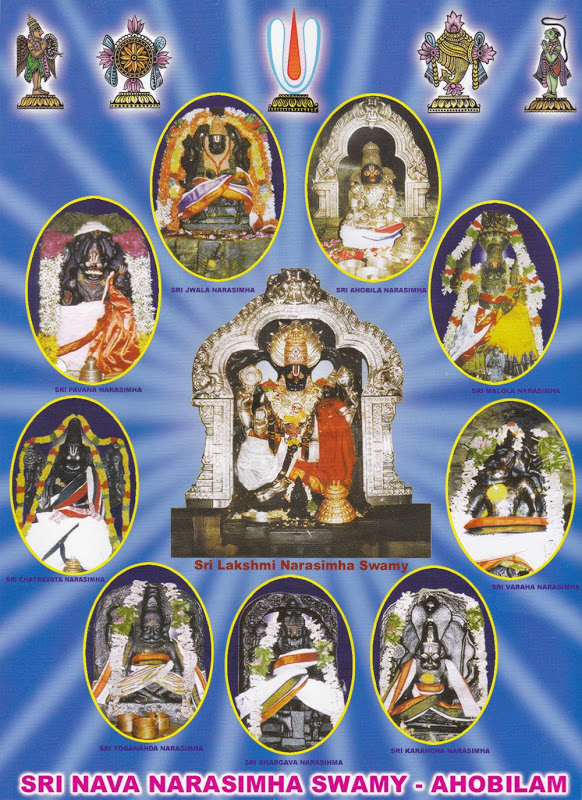 Ahobilam ( located in the Kurnool district of Andra Pradesh) is one of the most famous and significant pilgrimage sites for the devotees of Lord Vishnu in south India. This place is renowned for the Nava Narasimha Kshetrams, listed in the 108 Divya Desam temples dedicated to Lord Vishnu.
Ahobilam ( located in the Kurnool district of Andra Pradesh) is one of the most famous and significant pilgrimage sites for the devotees of Lord Vishnu in south India. This place is renowned for the Nava Narasimha Kshetrams, listed in the 108 Divya Desam temples dedicated to Lord Vishnu.
The largest and most famous statue in Hampi is of Lord Narasimha. Here, the Lord sits on the coiled snake, Adishesha, in a cross-legged position. The original statue had a Goddess Lakshmi sitting on Lord’s lap, but it was vandalised and destroyed.
The Yoga Narasimha temple is located on the Melukote hill, Karnataka. It is another famous temple of Lord Narasimha. Here, the great devotee Prahlada had consecrated the Idol. This temple is a testament to the devotion and reverence (that he held) for the Supreme and divine Lord.
The Lord Kampaheswara or Sarabeshwara temple, Thirubhuvanam, near Kumbakonam, is famous among the devotees of Lord Sarabha. King Kulothunga Cholan III built this temple. Here, Lord Sarabha has a separate shrine. He stands seven feet tall. Here, the devotees believe Lord Sarabha has the combined powers of Lord Shiva, Vishnu, Prathyangara Devi and Maa Durga.
Chaturvedimangalam, Sri Rudrakoteeswarar Temple at Sivaganga is another temple with a separate shrine for Lord Sarabeshwarar. The devotees actively pray to him for success and removal of hardships.
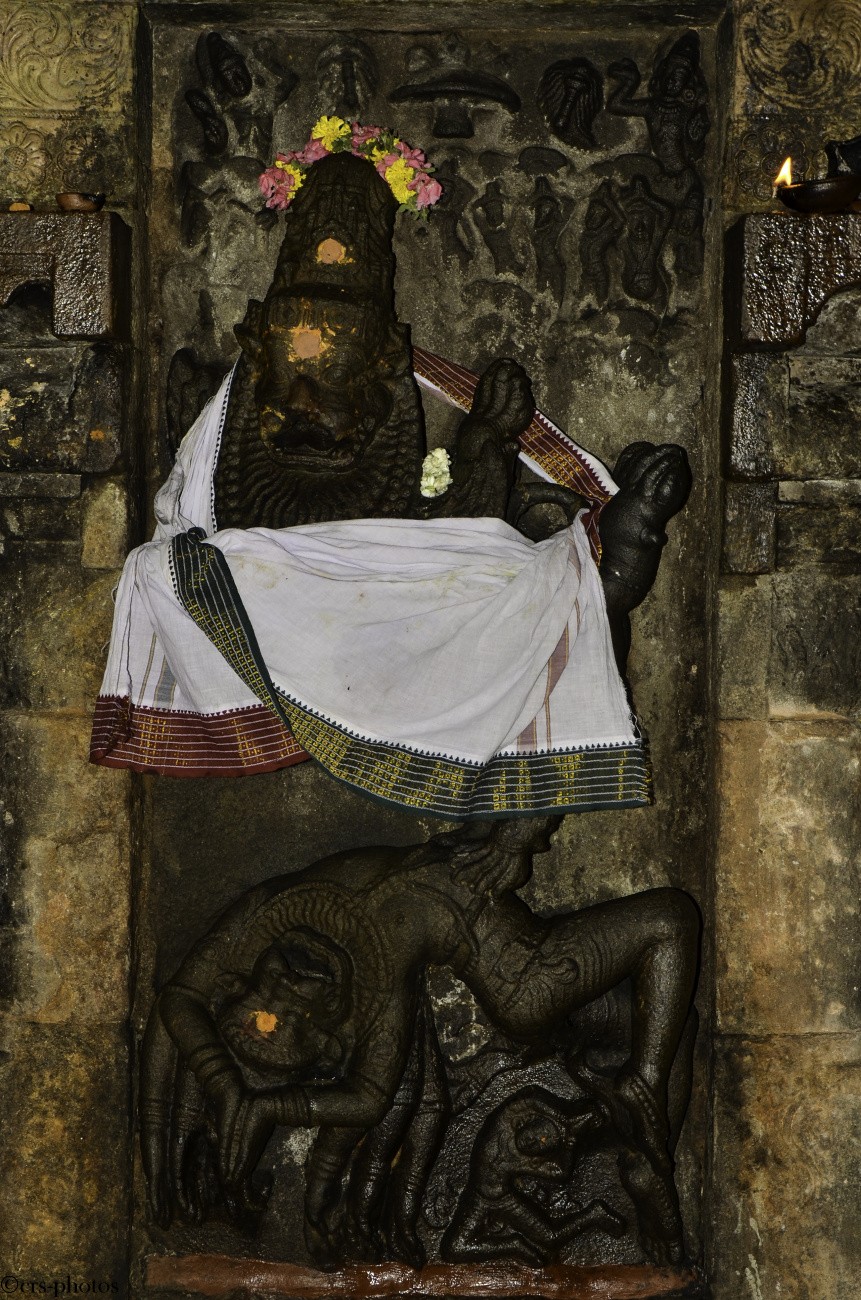 The Airavatesvara temple (Darasuram) near Kumbakonam is an architectural wonder. It is a UNESCO heritage site and one of the three living Chola temples ( where active worship and pooja take place). This temple stands out as one of the finest temples for sculptures and architectural masterpieces of the Chola reign. There is a statue of Lord Sarabha in this temple.
The Airavatesvara temple (Darasuram) near Kumbakonam is an architectural wonder. It is a UNESCO heritage site and one of the three living Chola temples ( where active worship and pooja take place). This temple stands out as one of the finest temples for sculptures and architectural masterpieces of the Chola reign. There is a statue of Lord Sarabha in this temple.
Many such temples have been built and dedicated to Lord Narasimha and Lord Sarabha. These temples are spread throughout the country. They offer solace to the devotees who still throng these divine destinations as a part of their pilgrimages or worship.
The most important message from these powerful stories of Avatars is not which God / Goddess is more powerful. These stories teach us humility and strengthen our faith and the spirit of acceptance. When water is poured into water, or milk when poured into milk, merge and become one; the pervading Lord Shiva and Lord Vishnu are wholly the same.
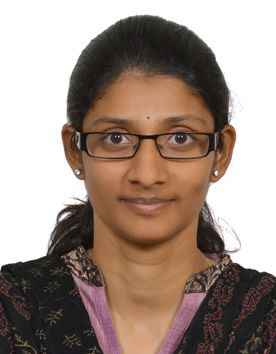 Vaishnavi Gurusankar is a passionate educator, a wife and a mother. She has over a decade of experience as an educator and has been closely working with teachers and children of all ages. She is also an active parenting blogger and founder of Magical Unicorn, an exclusive parenting blog founded on Indian ethos, values and stories at its core. She has also authored the book "Bharatyam : Science behind Hindu Practices & Way of Life"
Vaishnavi Gurusankar is a passionate educator, a wife and a mother. She has over a decade of experience as an educator and has been closely working with teachers and children of all ages. She is also an active parenting blogger and founder of Magical Unicorn, an exclusive parenting blog founded on Indian ethos, values and stories at its core. She has also authored the book "Bharatyam : Science behind Hindu Practices & Way of Life"
NEXT ARTICLE

At the southernmost tip of this mesmerising ensemble lies the majestic Great Nicobar Island, boasting an impressive landmass of about 910 square kilom...

Bharath has always been a land traversed by spiritual masters/ Guru since time immemorial. These spiritual masters have always upheld the core princip...

South India contains its fair share of unique pilgrimage centres. These divine places of worship have a prominent Sthala Purana, devoted followers, di...